Turning
an online music service into a powerful automated DJ isn't easy. You
can give an algorithm millions of songs and millions of data points, but
it's still not going to have any style. So of all your
options—including Google's new All Access—what's the streaming radio
most worth your time? We found out.
A decade
ago, when Pandora unleashed its service based on its Music Genome
algorithm, it was impressive enough that something so simple even worked
at all. You just punched in an artist or a song, and Pandora would
populate a playlist of similar stuff, and send it to you over the
Internet. Magic.
A lot's
changed since then. Today's best online music services are way more
powerful sound machines with slick interfaces, granular control over
what you're listening to, and loads of additional features that open the
door to a world of music you might never have otherwise discovered.
Let's talk about robotic taste...
Before
diving into the more sophisticated features of each of the services, I
did a little baseline test to see how well they could generate a simple,
single-artist playlist. After using each service for a couple of hours
so it got to know my taste a bit, I asked each service to make me a
station based on the 70s/80s British punk band Wire and took note of the
first 40 tracks played. Here's the breakdown of how many unique artists
each station played. (Note: There are other online radio services, like
upstart Songza, that don't offer generative playlists so we didn't
include them.)
Slacker: 21
Pandora: 21
Spotify: 23
Rdio: 23
Last.fm: 27
Mog: 29
Google Play Music All Access: 29
iHeartRadio: 36
In short,
there was a pretty broad discrepancy at even this simple task. That's
not to say more was better, though; while the services that generated
the least variety were noticeably repeating artists, stations with the
most variety often felt random, and in the case of iHeartRadio,
jarringly so. But they all basically got it done.
While
Pandora's Music Genome was first, it wasn't a very hard system to
replicate. In fact, most of these services are using the same core
brains: iHeartRadio, Spotify, Rdio, and Mog all pull their original
taste profiles from a company called the Echo Nest, which specializes in
music metadata for exactly this type of application. At a certain
point, the algorithm isn't worth re-engineering from the ground up.
Last.fm and Slacker have homegrown versions. It's not clear whether
Google built its own formula.
In other
words, the best radio experiences aren't powered by the smartest
algorithm—especially when the algorithms are all largely the same. A
confluence of factors, including everything from integration with social
networks to the design and overall usability of each service's unique
features adds up to a total package that's more meaningful than simple
numbers might suggest.
8th place: iHeartRadio
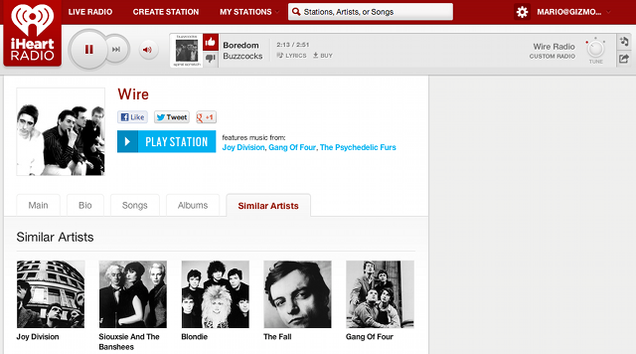
Even after
managing to belt out the most variety in our basic initial test,
iHeartRadio came out at the bottom of all of the services because it
does so little and doesn't do it especially well. After punching an
artist into iHeartRadio's search bar and launching a station, you can
fine-tune your station according to three settings—familiar, mixed, less
familiar—which are self-explanatory. (For the test above we turned the
variety up all the way whenever a service gave us the option.) Besides
the old song/artist/genre radio, you can play about 70 generic curated
radio stations. Oh, and the regular radio.
Really,
iHeartRadio is a radio in the most traditional sense. The Clear
Channel-owned company started out as a simple platform for listening to
the huge conglomerate's terrestrial radio stations from your computer.
And it's actually weirdly entertaining to listen to LA's KROQ all the
way from New York...for about a second, until you remember that regular
radio stations are terrible, which is why we turned to the Internet in
the first place.
Monthly price: Free
7th place: Pandora
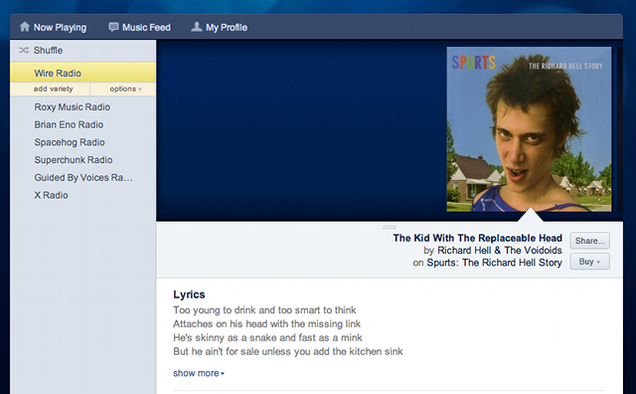
The
original gangster of Internet radio remains a very popular service, but
it's showing its age. It's also noticeably less evolved than some of its
counterparts. Beyond the basics, you can introduce variety to your
mixes by adding additional artists to the calculation. Or you can mix
everything together into a giant party shuffle.
Following
the success of services like Spotify, Pandora has added some very basic
social integration that lets you see what artist-based radio station
your Facebook friends are listening to, which is very basic compared to
other stuff out there.
If Pandora
has a selling point it's simplicity, but you get the sense that it still
harbors intense pretensions about the strength of its music genome. For
example, look at this explanation it just gave me for why I was hearing
a song:
mellow rock instrumentation, punk influences, extensive vamping, major key tonality and use of the wah pedal.
But as we learned before, there's nothing all that special about the algorithm.
Monthly price: Free (ad-supported, 40-hours maximum on mobile), $4 unlimited, ad-free
6th place: Last.fm
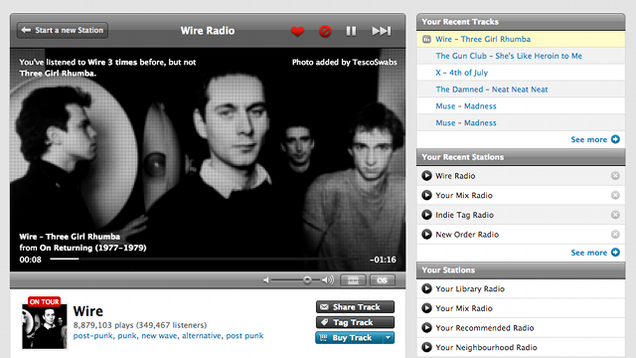
Last.fm's
interface feels ancient, and in a lot of ways, the service is a relic of
a time before technology was delivered in such precisely crafted
products. Basically, if you're the type of person who wants to
obsessively track every moment of what you listen to everywhere on the
web, then this is the service for you. There are apps—both homegrown and
third-party—that
use Last.fm's API to pull data from what you're listening to and send
it back to your listening history on the service. Your iTunes, Spotify,
and YouTube history in a single place is a wonderfully nerdy thing. From
there you can get RSS feeds—RSS!—of your favorite songs, or of your
recently played songs. Or you can add new metadata tags to songs. Or you
can write in a music journal. You get the point.
Still, all
of that data makes Last.fm more of a recommendation engine than a
polished way to listen to music. Using your data, it will serve up some
choice stuff you've never heard of, as you dig around in the community,
Last.fm opens itself up in the way a record collection used to. Luckily,
because Last.fm's platform is open, you can take advantage of all of
its good parts, and use it to improve other services with better user
interfaces.
Monthly price: Free or $5 if you want to listen to music on the standalone desktop app.
5th place: Mog
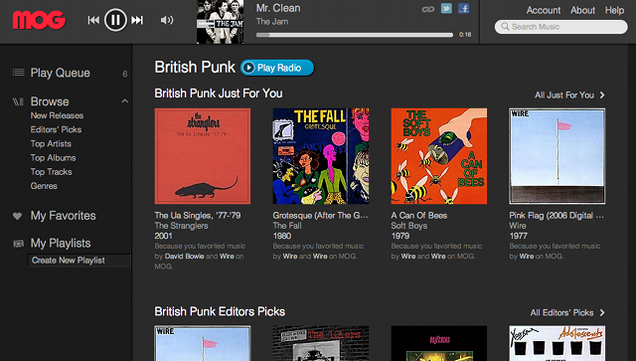
Mog is the
on-demand streaming music service recently acquired by Beats Audio, and
is full of nice touches that make it feel more sophisticated than it
really is. And there's no better example of how design can make
something fun than the service's 11-position HTML 5 slider that allows
you to fine-tune your mix, from just a single artist to maximum variety.
Man, that slider makes you feel like you're in control, even if that
level of granularity doesn't actually have much of an effect in
practice.
Besides the
basic song/artist/genre method for starting points you can also browse
what's trending on the service, or if you link Mog up with Facebook, you
can see what your friends have been rocking out to also.
None of
this is all that special, but the service is visually lush, and fun to
browse around. Even if it's not presenting you with anything but someone
else's metadata categories, it's fun to follow Mog's long lists of
related artists and sub-sub genres.
Monthly price: Free (ad-supported), $5 unlimited music on your computer, $10 unlimited music including mobile.
4th Place: Slacker
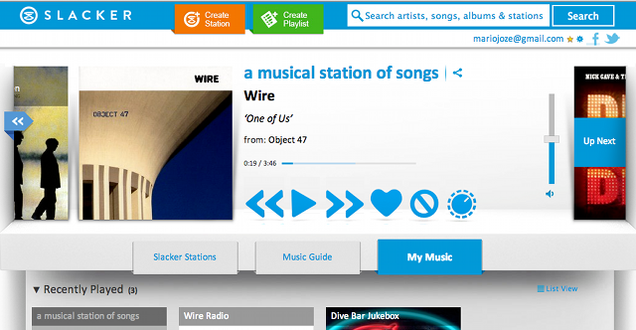
Its on-demand service notwithstanding, Slacker's focus has always been radio, and importantly, curated radio stations. This is real radio because it's assembled by real people rather than by an algorithm. Many of these stations are excellent. I've been a big fan of stations like Dive Bar Jukebox, which plays everything from contemporary cult hits to vintage soul. It provides the kind of variety you can't really get from a machine.
But trends
being what they are, Slacker has had to evolve its generative playlist
features to keep up with everyone else. A few months ago, Slacker
launched a redesign centering around intensely fine control over what
you're listening to. In other words, after you make an artist-based
playlist, you can tweak the mix of music with six different sliders,
which can be used to create some interesting blends.

Slacker's
new UI is ambitious and it's very good-looking, but it's pretty
confusing too. Everything is dynamic and some menu is always sliding out
from somewhere. The whole thing needs some streamlining.
More
importantly, though, Slacker has completely missed the potential of
social—which it actually sees as one of its selling points to people who
are embarrassed about their musical taste. No matter how powerful those
curated stations are, there's no better indicator of what you're going
to like than what your friends like.
Monthly price: Free ad-supported, $5 unlimited radio with mobile station caching, $10 unlimited radio and on-demand music.
3rd Place: Google Play All Access
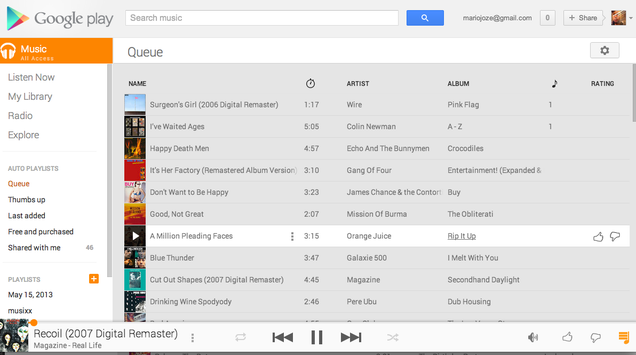
Google's newly-launched subscription service makes being easy look, er, easy. As I noted in my hands-on impressions, it's minimal in all the right ways. It feels like a more powerful service than it is because the navigation is so easy. You hardly ever need to click more than twice to switch up what you're listening to.
All of
this, though, masks the fact that Google's radio offering is a very
basic artist/album/song station generator. Subjectively, I think All
Access made the best playlists of any of the services. And that's
without any way to modify the variety of what you're listening to.
Sobresaliente!
But when it
comes to getting beyond your own taste—and the taste of Google's
obviously excellent algorithm, All Access leaves you all alone. You're
pretty much stuck with boring brain. You've got very little idea what
anybody else is listening to because All Access only connects with
Google+. Sorry, no Facebook, no standalone social network, no way to
look at other people's playlists. All you get is the option of pushing a
post with what you're listening to onto Google+. Lame.
2nd Place: Spotify
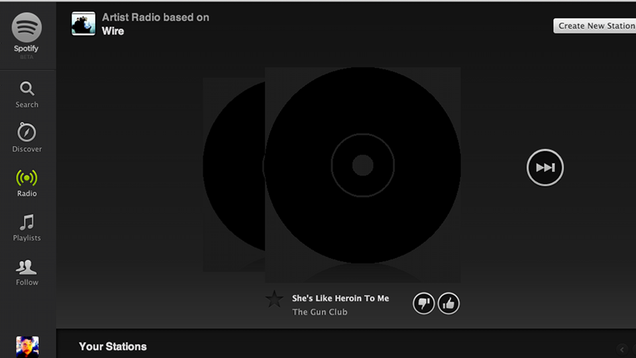
Spotify
just rolled out its new web-based UI, which goes a long way towards
fixing the catastrophe of an interface it had before. Don't get me
wrong, Spotify was probably the most-important on-demand pioneer, and
along with Rdio, Spotify was amongst the first to show how important
social integration could be.
The new
interface erases the distinction between radio stations and playlists.
Every time you make a playlist from Spotify's catalog, the it's added to
your list of stations as well. Spotify has been listening very
carefully to what people want, which is why the new look is centered
around a flashy "Discover" page, which recommends artists, playlists,
and other users based on your taste.
The problem
with Spotify's Discover tab is that it can feel like a disorienting
jumble of artist and song recommendations when you're just trying to
pick something. There are some nice touches to the UI, but it's a little
too much reading and thinking to be an easy way to jump off a listening
session.
What's
more, Spotify still hasn't managed to make social totally useful to
listening to stuff. The new design conflates following your friends with
following international music superstars. You can listen to your
friends playlists. That's neat! But realistically, you don't want
something your friends have curated—you want to know what they're
listening to a lot.
Monthly price: Free on-demand on your computer (ad-supported), $5 on-demand on your computer, $10 on-demand including mobile.
Bestmodo: Rdio
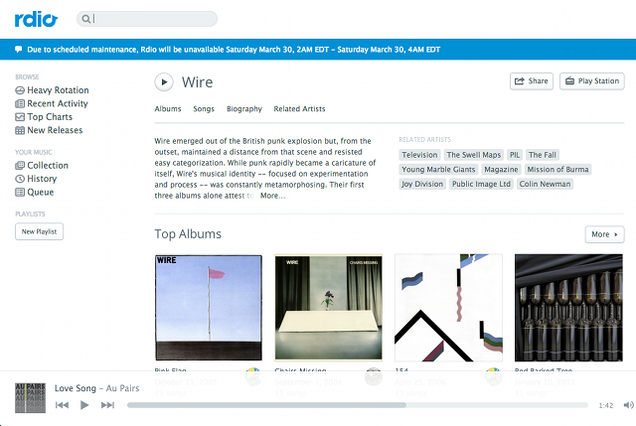
Rdio kills
this test on the strength of is UI and social integration. Link Rdio up
with Facebook, and it's impossible not to find new music from your
friends, or even, to find new friends on Rdio with good taste in music.
Who knew music discovery could get you laid?
And that's
really important. Rdio takes a lot of the thinking out of generating a
station. You can go the traditional song/artist/genre/trending routes
we've been talking about all day, or it'll make you a station based on a
playlist you've got as you can on Spotify. But Rdio's options keep
going. How about a station based on your best friend's most-played
albums? Or a station based on stuff that's trending in your network? You
could create these stations yourself manually, but Rdio skips that step
and just crunches the data to create the playlist for you. And
remember, everybody is basically working with the same data.
Monthly price: $5 unlimited music streaming on your computer (including on-demand), $10 unlimited music including mobile.
Source: http://gizmodo.com/the-best-streaming-radio-486515844
Source: http://gizmodo.com/the-best-streaming-radio-486515844
